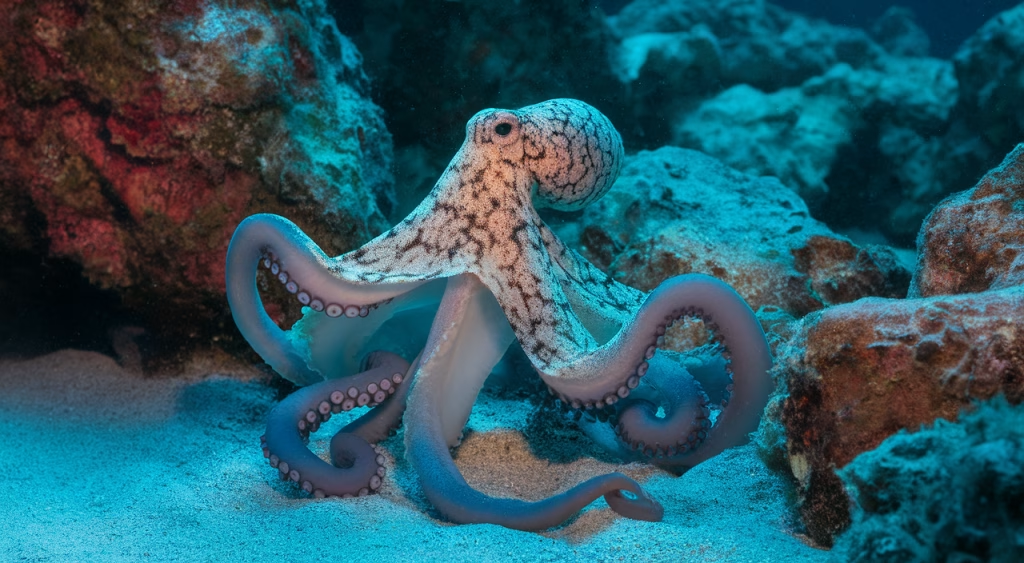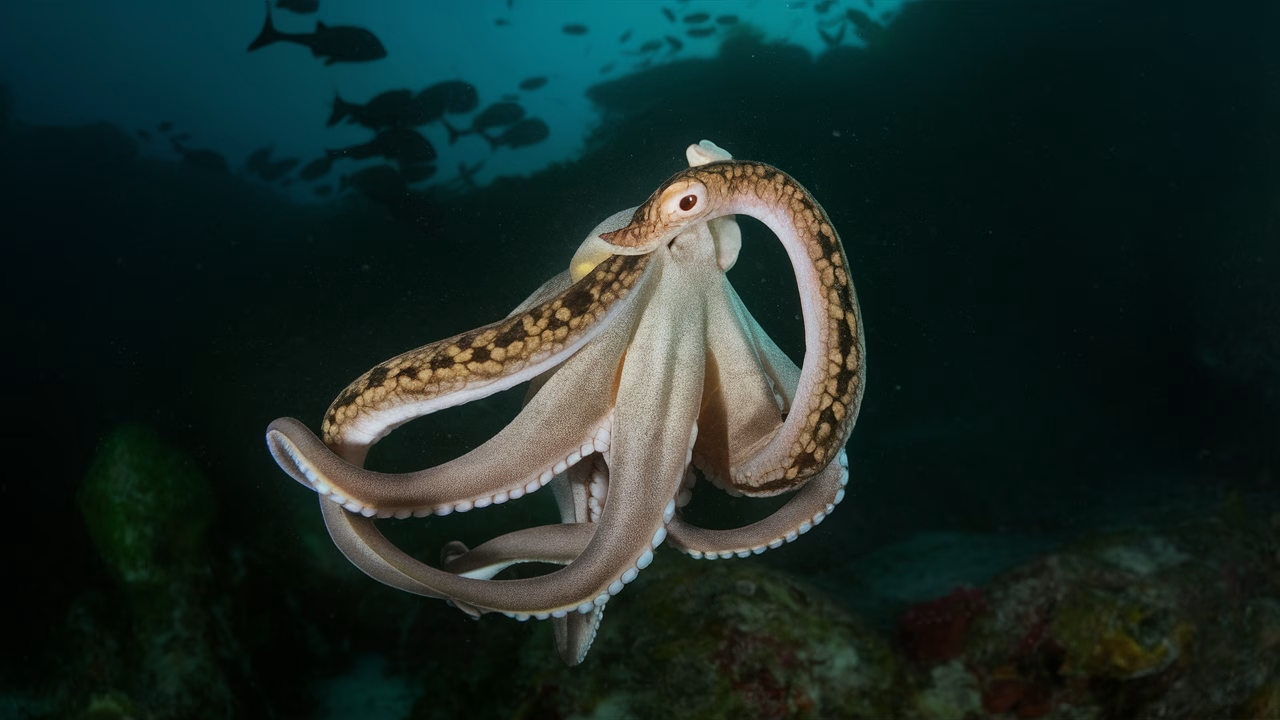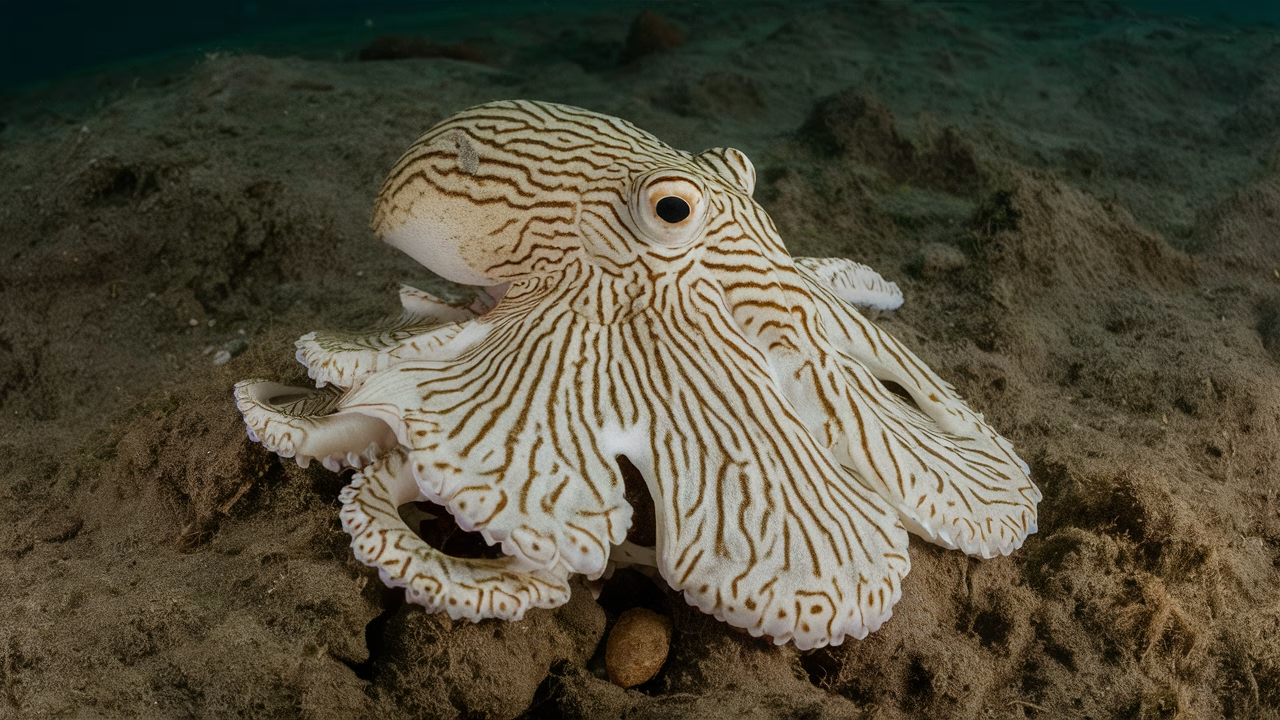How does the mimic octopus impersonate sea snakes and lionfish?
The mimic octopus uses a unique combination of posture, color change, and arm manipulation to imitate dangerous sea creatures like sea snakes and lionfish. These impersonations aren’t just for show—they serve a life-saving purpose by deterring predators.
TL;DR: How mimic octopus impersonation works
- Mimic Mastery: The mimic octopus can impersonate up to 15 species, including lionfish, sea snakes, and jellyfish.
- Adaptive Strategy: This mimicry is a defense mechanism used to outwit predators by appearing more dangerous than it really is.
- Scientific Interest: Studies show mimicry changes depending on the type of threat faced.
- Microhabitat Dependent: They thrive in murky waters where these illusions are more convincing.
The art of mimicry by the mimic octopus
1.1 Discovering the mimic octopus
Discovered in 1998 off the coast of Sulawesi, Indonesia, the mimic octopus (Thaumoctopus mimicus) instantly fascinated researchers and divers alike. What sets this remarkable cephalopod apart from other octopuses isn’t just its ability to change color and texture—but its capacity to mimic the actual shape and behavior of other species.
Unlike other octopuses that use camouflage to blend with their surroundings, this species goes a step further with its impersonation techniques. It manipulates its body and movement to impersonate venomous or aggressive sea animals. Why? To say, “I’m more dangerous than I look!”—a clever ruse that keeps predators at bay.
1.2 Impersonation of sea snakes
When you observe a mimic octopus threatened by predators like damselfish, you’ll witness an extraordinary transformation. The octopus tucks six of its arms into a burrow and raises the remaining two, creating the illusion of a slithering sea snake. It even recreates the black and white banding pattern of the venomous banded sea krait.
This sea snake impersonation not only confuses attackers but actively dissuades them, since sea snakes are notorious predators themselves. For the mimic octopus, this smart trick can mean the difference between life and death.
Mimic octopus vs. lionfish
2.1 Mimicking the lionfish’s spines
The lionfish, with its iconic fan of venomous spines, commands respect in marine ecosystems. When facing certain threats, the mimic octopus adopts this intimidating guise by extending its arms in radial fashion, rippling them as it glides across the sea floor.
What makes this lionfish impersonation so incredible is not just the shape but the movement. The octopus mirrors the lionfish’s sinuous swimming style down to minute details, presenting itself as too risky to attack.
For you as a wildlife enthusiast or diver, witnessing this behavior is a rare but awe-inspiring sight—and a reminder of just how sophisticated marine life can be when it comes to survival tactics.
Scientific studies and observations
3.1 Understanding the behavior of the mimic octopus
Mimic octopus behavior isn’t static—it’s dynamic and intelligent. A 2001 study published in the Biological Journal of the Linnean Society revealed that the mimic octopus tailors its impersonations based on specific threats. For example, if it’s chased by a damselfish that’s known to fear sea snakes more than lionfish, it’ll default to the sea snake impersonation.
In field observations, mimicry in this species isn’t always instant. Young mimic octopuses develop their impersonation techniques gradually through learning and practice. The degree and choice of mimicry also appear to vary between individuals, suggesting environmental adaptation and individual learning capabilities.
Behavioral biologists frequently use this octopus as a case study for “protean behavior”—survival strategies involving unpredictability and adaptive responses.
Other creatures mimicked by the mimic octopus
4.1 Jellyfish and zebra sole impersonations
While the lionfish and sea snake impersonations steal the spotlight, the mimic octopus has an entire toolkit of disguises. It can balloon its body upward and undulate its arms to look like a pulsing medusa jellyfish—an appearance that’s both ghostly and off-putting to many predators.
Another remarkable impersonation involves the zebra sole—a flatfish with a wide, wing-like body. The mimic octopus flattens its body and swims across the seabed with a gliding motion that’s nearly indistinguishable from the real thing. This disguise helps it slip past larger predators that typically ignore flatfish.
What’s fascinating about these mimic octopus facts is that the impersonations aren’t perfect copies. Instead, they’re “good enough” illusions, perfectly tuned to the low-visibility world of turbid coastal waters where this species thrives.
Final thoughts: What the mimic octopus teaches us
Standing at the crossroads of evolution, deception, and intelligence, the mimic octopus serves as a remarkable example of adaptability in our oceans. Its ability to impersonate multiple species through sophisticated impersonation techniques is more than a parlor trick—it’s a testament to the complexity of marine life and the countless mysteries still beneath the waves.
Whether you’re a diver, marine biologist, or simply someone fascinated by the wonders of sea creatures, the mimic octopus invites us to look closer, think deeper, and marvel at the incredible adaptations that help marine life survive.
Frequently Asked Questions
- How does the mimic octopus know which animal to mimic?
It adapts its mimicry based on the type of predator it encounters, often choosing the most threatening impersonation to deter attacks. - What animals can the mimic octopus imitate?
Known examples include lionfish, sea snakes, flatfish (zebra sole), jellyfish, and sea anemones. - Can all mimic octopuses mimic the same species?
Most can mimic the usual suspects, but some individual variation occurs depending on region and learning. - Is the mimic octopus venomous?
No, it relies entirely on visual deception and mimicry rather than venom for defense. - Where can you find mimic octopuses in the wild?
They inhabit the shallow, silty waters of Southeast Asia, especially Indonesia and Malaysia. - How big does a mimic octopus grow?
Mature individuals typically reach about 60 cm (around 2 feet) when fully extended.





